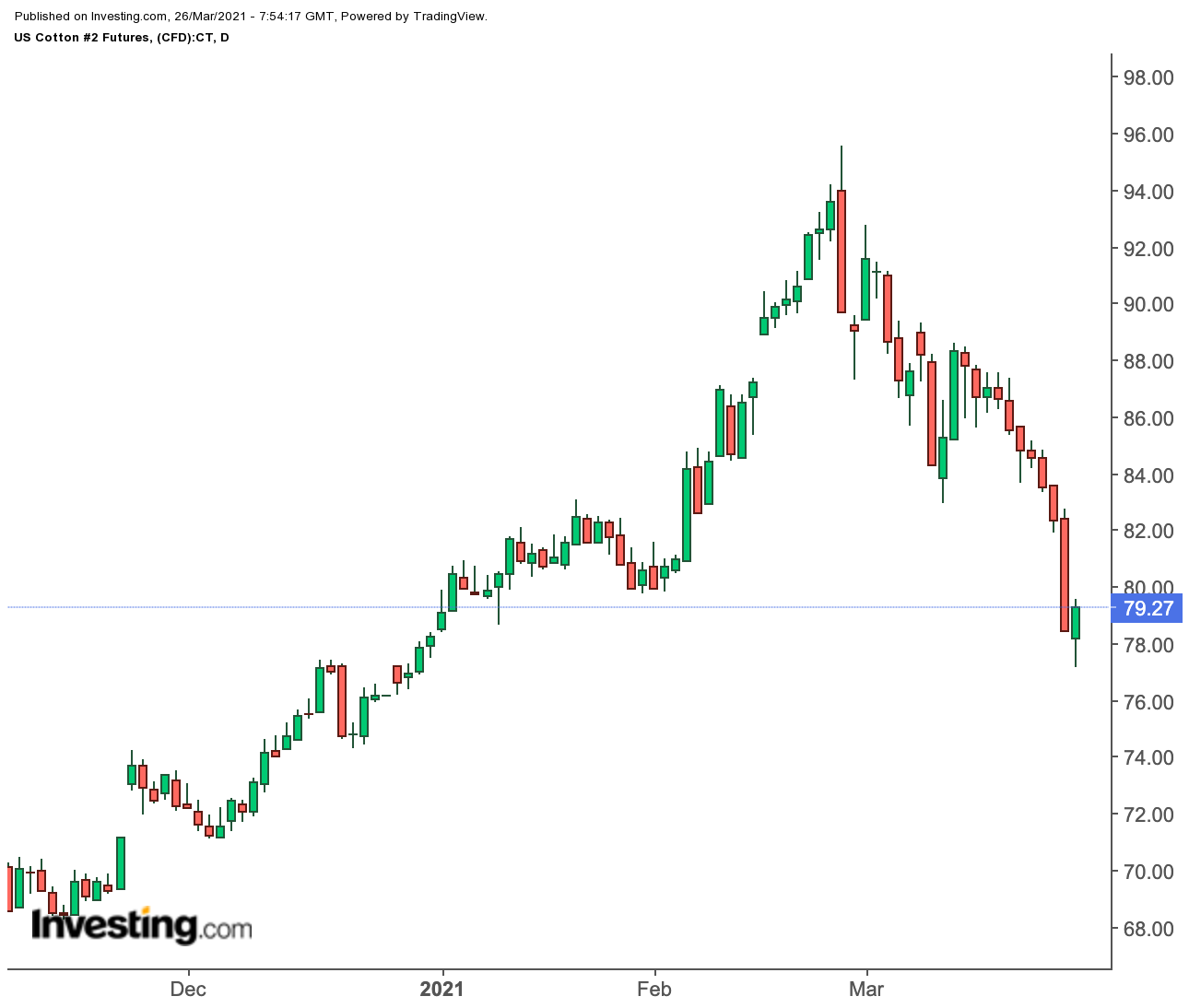Cotton prices are headed for their worst monthly loss since the start of the coronavirus pandemic as the US-China row—which has pulled in fashion labels including Nike (NYSE:NKE) and H&M (OTC:HNNMY)—puts a damper on a commodity that had been projected to have its biggest export year since 2012.
As of Friday, New York-traded cotton futures were on track to finish this month down 12%, their sharpest fall in exactly one year since the global outbreak of COVID-19 left the commodity with a 17% loss in March 2020.

The price situation in cotton jars with the rosy business outlook projected for the commodity just two weeks ago by the US Department of Agriculture.
Unveiling its market outlook on Mar. 11, the USDA said it expected the world to trade 44.5 million bales of cotton for crop year 2020/21—nearly 8% above 2019/20 levels and the highest since 2012/13.
The exports surge was attributed to the boom expected in cotton milling demand this year as economies recover from the pandemic resulting in higher consumption in everything from textiles to bath products, livestock feed and fertilizer, plastics, paper and cardboard.
Sudden Halt To Cotton’s Stunning 10-Month Rally
Right until that USDA outlook, cotton futures had an almost uninterrupted run-up between April 2020 and February 2021, during which they gained a net 55% to reach around 89 cents per lb from the pre-rally price of about 57 cents.
But as March arrived, the US-China row on cotton, in place since the Trump administration, came to the boil as the White House under President Joseph Biden hit out at “China’s unfair trade practices” and alleged mistreatment of Muslim Uighurs in the northwest Chinese region of Xinjiang.
For context, a week before leaving office in January, former President Donald Trump blacklisted 87% of China’s cotton crop—or one-fifth of the world’s supply — grown in Xinjiang.
The Biden administration’s tendency to dip into the Trump playbook on China, rather than have a reset in relations, wasn’t missed by markets, including cotton, which began a serious slide from mid-March.
In the last two weeks, the crisis in cotton deepened as Xinjiang region officials came under fresh Western sanctions. Cotton futures fell nearly 3.5% during the week ended Mar. 12 and another 8% in the week to Mar. 19.
Nike, H&M Among Brands Caught In Crosshairs Of Cotton Fight
Matters came to a head on Thursday when Western fashion brands including Nike and H&M faced boycott calls from China as Beijing pushed back with increasing ferocity against allegations of human rights abuses toward its Uighur community.
China Central Television underscored the sentiment among Chinese consumers when it said on its social media account that "for enterprises that touch the bottom line of our country, the response is very clear: don't buy!"
Nike provided the fuel for the blowup when it said in a statement that it was “concerned about reports of forced labor in, and connected to, the Xinjiang Uighur Autonomous Region”.
H&M tried to toe a safe line by saying it was “committed to long-term investment and development in China" and had operated in the country in an "open and transparent manner", without "any political position”. It also said it “continues to respect the Chinese consumer”.
Despite that, there were calls to boycott.
State-controlled media and online users also criticized German sportswear giant Adidas (OTC:ADDYY) and American brand Tommy Hilfiger.
The hashtag #ISupportXJCotton (XJ being the abbreviation for Xinjiang) generated more than 2 million 'likes' on the Chinese social media platform Weibo (NASDAQ:WB).
The fallout continued offline too, with Chinese celebrities quick to disassociate themselves from the brands and tear up endorsement deals. Popular actor Wang Yibo terminated his contract with Nike.
Forget The Row—Cotton Still Has A Great Lookout This Year
It is not known how much longer the US-China spat will weigh on cotton prices.
Notwithstanding the crisis, crop analysts said cotton has a lot going for it this year, due to the projected economic recovery from the pandemic and poorer growing conditions of late in places like Brazil—the world’s fastest growing cotton producer.
Jack Scoville, who heads crop research for Price Futures Group in Chicago, said in a note on Thursday that while the downtrend in daily price charts of cotton had steepend, “demand in the export market has been strong even with the coronavirus”.
He added:
“The strong demand could continue as the USDA has also cut Brazil production estimates due to reduced planted areas this year. The US stock market has been generally firm too, supporting the notion of an improving economy and higher demand potentially for cotton products.”
That concurs with what the USDA said earlier this month.
Leading the way for the global cotton trade this year will be the United States and Brazil, which are projected to have 35% and 22%, respectively, of world exports.
Global cotton mill use in 2020/21, meanwhile, is projected at 117.5 million bales, 14.5 percent above last season’s 16-year low.
On the other hand, world cotton production in 2020/21—led by China and India—is projected at 113.3 million bales, 7% below 2019/20 and the smallest crop in 4 years.
With mill use exceeding production, global cotton stocks are forecast to decrease this season. World cotton stocks in 2020/21 are forecast at 94.6 million bales—a 4% reduction. Consequently, a lower global stocks-to-use ratio is also forecast in 2020/21 and supports the higher cotton prices experienced this season.
Disclaimer: Barani Krishnan uses a range of views outside his own to bring diversity to his analysis of any market. For neutrality, he sometimes presents contrarian views and market variables. He does not hold a position in the commodities and securities he writes about.
